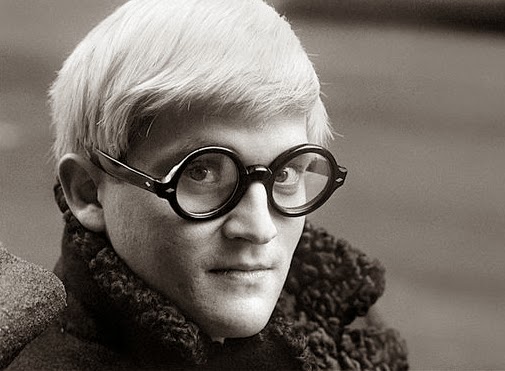 |
| ( David Hockney) |
A visit to California, where he subsequently lived for many years, inspired him to make a series of paintings of swimming pools in the comparatively new acrylic medium rendered in a highly realistic style using vibrant colours. The artist moved to Los Angeles in 1964, returned to London in 1968, and from 1973 to 1975 lived in Paris. He moved to Los Angeles in 1978, at first renting the canyon house he lived in and later bought the property and expanded it to include his studio. He also owned a 1,643-square-foot beach house at 21039 Pacific Coast Highway in Malibu, which he sold in 1999 for around $1.5 million.
Hockney is openly gay, and unlike Andy Warhol, whom he befriended, he openly explored the nature of gay love in his portraiture. Sometimes, as in We Two Boys Together Clinging (1961), named after a poem by Walt Whitman, the works refer to his love for men. Already in 1963, he painted two men together in the painting Domestic Scene, Los Angeles, one showering while the other washes his back.In summer 1966, while teaching at UCLA he met Peter Schlesinger, an art student who posed for paintings and drawings.
On the morning of 18 March 2013, Hockney's 23-year-old assistant, Dominic Elliott, died as a result of drugs, drinking acid and alcohol at Hockney's Bridlington studio. Elliott was a first- and second-team player for Bridlington rugby club. It was reported that Hockney's partner drove Elliott to Scarborough General Hospital where he later died.
Work
Hockney made prints, portraits of friends, and stage designs for the Royal Court Theatre, Glyndebourne, La Scala and the Metropolitan Opera in New York City. Born with synesthesia, he sees synesthetic colours in response to musical stimuli. This does not show up in his painting or photography artwork, but is a common underlying principle in his designs for stage sets for ballet and opera—where he bases background colours and lighting on the colours he sees while listening to the piece's music.
Portraits
 |
| Mr and Mrs Clark and Percy (1970–71), Tate Gallery, London |
Hockney painted portraits at different periods in his career. From 1968, and for the next few years he painted friends, lovers, and relatives just under lifesize and in pictures that depicted good likenesses of his subjects. Hockney's own presence is often implied, since the lines of perspective converge to suggest the artist's point of view. Hockney has repeatedly returned to the same subjects - his parents, artist Mo McDermott (Mo McDermott, 1976), various writers he has known, fashion designers Celia Birtwell and Ossie Clark (Mr and Mrs Clark and Percy, 1970–71), curator Henry Geldzahler, art dealer Nicholas Wilder, George Lawson and his ballet dancer lover, Wayne Sleep.
On arrival in California, Hockney changed from oil to acrylic paint, applying it as smooth flat and brilliant colour. In 1965, the print workshop Gemini G.E.L. approached him to create a series of lithographs with a Los Angeles theme. Hockney responded by creating a ready-made art collection.
On arrival in California, Hockney changed from oil to acrylic paint, applying it as smooth flat and brilliant colour. In 1965, the print workshop Gemini G.E.L. approached him to create a series of lithographs with a Los Angeles theme. Hockney responded by creating a ready-made art collection.
 |
| (David Hockney walking front of largest canvas then life) |
(Source from Wikipedia, the free encyclopedia more read )

